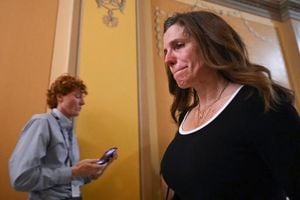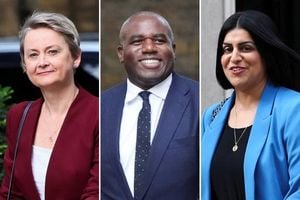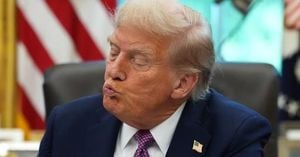The Federal Reserve, under the leadership of Chairman Jerome Powell, is facing turbulent waters as the consequences of its monetary policies and the newly elected President Donald Trump’s ambitions come to the fore. With rising speculation surrounding interest rates and their future path, American households are grappling with the repercussions of high borrowing costs, which are poised to shape the financial climate.
President-elect Trump has repeatedly signaled his intentions to ease the financial burden on American families by advocating for lower interest rates. Yet, as many economists predict, interest rates might stay elevated, contradicting Trump’s promises. This potential clash ties closely to the Fed's independence, which Powell reaffirmed when he stated, “That gives us the ability to make decisions for the benefit of all Americans at all times, not for any specific political party or political outcome.”
The looming question is whether Trump’s economic policies will create friction with the Fed. With the economy operating close to full capacity, any proposals for tax cuts and increased tariffs could very likely reignite inflation, forcing the Fed to keep rates high. Olivier Blanchard, the former top economist at the International Monetary Fund, expressed this fear, noting the high risk of conflict between Trump and the Fed. If inflation spikes due to expanded tariffs—a Trump promise—the Fed may find itself behind the curve, unable to effectively respond to the administration’s aims.
Currently, the Fed’s approach has been cautious, having cut interest rates only minimally, with expectations of perhaps three cuts throughout the year 2025. Powell's recent public comments suggested restraint, as the economy remains unexpectedly strong. The premise for many investors is the belief, supported by the CME Group's FedWatch tool, of rate cuts coming, including one at the upcoming December 18 Federal Reserve meeting.
Still, with inflationary pressures potentially on the rise, especially from Trump’s proposed economic initiatives, the Fed's discretion may become limited. Powell has indicated the central bank’s pace of forthcoming rate cuts would not be particularly aggressive. He remarked at the DealBook Summit, “The economy is stronger than the Fed expected, and the Fed can afford to be more cautious as it lowers rates.”
For homeowners, the effects of these rate controls are undeniable. The current rates on 30-year mortgages hover at around 6.8%, significantly lower than the 8% seen just last October—a faint glimmer of good news for potential buyers. Despite optimism, any abrupt shifts due to political and economic misalignment may keep mortgage rates elevated longer than homeowners would wish.
Complicatively, Trump’s policies may require even more capital, impacting Treasury rates significantly. This dynamic serves to complicate the relationship between the Fed and the administration, particularly because Powell’s tenure as Chairman doesn’t end until 2026. Early predictions suggested Trump might make aggressive moves against Powell, even hinting at resignation for the Fed chair due to not gaining adequate control over the institution.
Powell, when questioned about resignation, simply replied “No.” His steadfast commitment to the Fed's independence shines through amid potential political repercussions. Critics argue, though, persistent criticism of the Fed and its leadership from Trump could signal to the markets and analysts alike of potential political pressure, undermining the Fed's perceived independence.
A significant concern for many is how the Fed maintains control over economic rates through its trading activities, primarily through the New York Federal Reserve Bank's desk buying and selling Treasury securities to influence interest rates. This complicated interplay means decisions about short-term rates affect the larger borrowing environment, laying the groundwork for determining the economic flow.
Previous experiences have showcased the risks involved with political pressure on the Federal Reserve; the most notable being President Nixon, who pressured the Fed to cut rates during his campaign, resulting in lengthy, stubborn inflation issues. History tends to hold lessons about the delicate balance of political influence on financial institutions, and economists fear repeating those generations-old mistakes.
Trump's goal-oriented approach requires careful navigation of economic policy, especially when it collides head-on with the Federal Reserve's strategic interests. The outcomes of this dynamic will likely dictate the financial health of Americans as pressures mount, making the coming months instrumental for families across the nation, whether they’re dealing with purchasing homes or managing other debt responsibilities.
Overall, as attitudes shift and the 2025 interest rate forecasts emerge, the intersection of political ambitions and centralized economic control continues to elicit widespread attention. Investors will watch closely as this multifaceted conflict develops, particularly with upcoming Fed meetings heralding the potential for change. The Fed's commitment to independence and sound economic judgment remains imperative to curbing rising inflation and promoting overall fiscal health.



